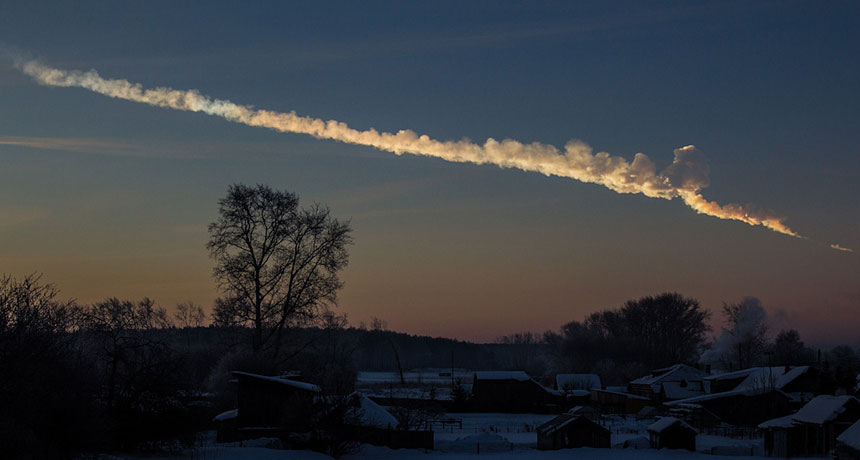An alarm system for Earth crashers
The ATLAS telescope will spot smaller asteroids that other surveys miss

The line of cloud across the sky is the train of a dawn meteor north of Chelyabinsk, Russia.
Alex Alishevskikh/Wikimedia Commons/(CC BY-SA 2.0)
By Ilima Loomis
The term “killer asteroid” might bring to mind the kind of massive space rock that wiped out the dinosaurs millions of years ago. But such a large object — around 5 to 15 kilometers (3 to 8 miles) across — might hit Earth only once every few hundred million years. Smaller space objects hit more often. And even these minis can be dangerous. An asteroid just 45 meters (50 yards) wide could destroy a city. But the first in a new two-telescope system in Hawaii has just begun scanning the skies for such “city-killers.” And what it finds might give people a life-saving warning of their approach.
Such incoming space rocks are called near-Earth objects, or NEOs. Because most are fairly small, they often aren’t visible until they are just a few days away. The tend to fly past Earth and disappear again without ever being noticed by astronomers. But not all miss us. Some strike the planet. And even those that are tinier than city-killers can be devastating.
Consider the Chelyabinsk meteor that exploded over Russia in 2013. The rock was only about 17 meters (56 feet) across. But it damaged buildings over a broad area and injured more than 1,000 people.
A new Asteroid Terrestrial-impact Last Alert System — or ATLAS — is designed to spot these smaller asteroids before they strike. This kind of “asteroid alarm” could give people a few days’ warning to prepare or evacuate the cities in a space rock’s flight path.In most cases, “the things that hit us are small,” says Nick Moskovitz. He’s an astronomer and asteroid researcher at Lowell Observatory in Flagstaff, Ariz. “The chance of us getting hit by something the size of a dinosaur-killer are so small, we’d have tons of advance notice,” he says. It’s the little rocks that are usually the surprises.
There are already powerful telescopes searching for asteroids. What makes ATLAS unique is that it will scan the entire sky several times per night. Other surveys make only about one scan per week.
Moskovitz is not working on ATLAS. Yet even he believes “It’s one of the most exciting projects in the [NEO] field right now.”

“ATLAS will be the first NEO survey that targets the whole sky every night,” says Heinze. The project will take a picture of every part of the sky about four times each evening. Scientists will use a computer program to compare the images. Any object that moved or changed position over hours or days, Heinze says, is a likely asteroid.
“I’ve been quite surprised at how much the other surveys were missing,” he says. And, it turns out, not all of the missed asteroids were small. ATLAS has already spotted objects that the more powerful surveys would be expected to catch. Yet some of these space rocks had slipped through the cracks. They included objects around 150 meters (490 feet) across — as in city-killer size.
But ATLAS isn’t just for planetary defense, Heinze notes. It also is useful for scientific research. Scientists don’t know much about smaller NEOs because they are faint and hard to observe. Researchers don’t even have an estimate of how many might enter Earth’s neighborhood each year. Just getting a count will help scientists understand them better.
“Right now,” Moskovitz says, “most of these objects in the school-bus-size range fly by the Earth without us ever knowing about it.”
Power Words
(for more about Power Words, click here)
asteroid A rocky object in orbit around the sun. Most orbit in a region that falls between the orbits of Mars and Jupiter. Astronomers refer to this region as the asteroid belt.
astronomy The area of science that deals with celestial objects, space and the physical universe as a whole. People who work in this field are called astronomers.
dinosaur A term that means terrible lizard. These ancient reptiles lived from about 250 million years ago to roughly 65 million years ago. All descended from egg-laying reptiles known as archosaurs. Their descendants eventually split into two lines. They are distinguished by their hips. The lizard-hipped line became saurichians, such as two-footed theropods like T. rex and the lumbering four-footed Apatosaurus (once known as brontosaurus). A second line of so-called bird-hipped, or ornithischian dinosaurs, led to a widely differing group of animals that included the stegosaurs and duckbilled dinosaurs.
meteor A lump of rock or metal from space that hits the atmosphere of Earth. In space it is known as a meteoroid. When you see it in the sky it is a meteor. And when it hits the ground it is called a meteorite.
NEO An abbreviation for near-Earth object, an asteroid making a close approach to Earth.
planet A celestial object that orbits a star, is big enough for gravity to have squashed it into a roundish ball and it must have cleared other objects out of the way in its orbital neighborhood. To accomplish the third feat, it must be big enough to pull neighboring objects into the planet itself or to sling-shot them around the planet and off into outer space. Astronomers of the International Astronomical Union (IAU) created this three-part scientific definition of a planet in August 2006 to determine Pluto’s status. Based on that definition, IAU ruled that Pluto did not qualify. The solar system now includes eight planets: Mercury, Venus, Earth, Mars, Jupiter, Saturn, Uranus and Neptune.
telescope Usually a light-collecting instrument that makes distant objects appear nearer through the use of lenses or a combination of curved mirrors and lenses. Some, however, collect radio emissions (energy from a different portion of the electromagnetic spectrum) through a network of antennas.







